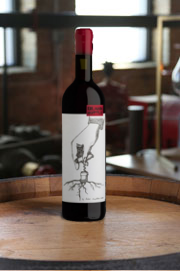- Analysis
- Vineyards
- Vinification and Aging
- Tasting Notes
- 2013 Vintage Notes
2013 RAW
Wine of Origin
Goudini (Ward of Breedekloof, which is a District within the Breede River Valley)
Varietals
100% Nebbiolo
Analysis
Wine Maker: Pieter H. Walser
Alcohol: 14.5%
Total Acidity: NA
pH: NA
Total Production: NA
Owning a farm limits you to the vineyards on your specific farm. I love traveling and experiencing many different areas. I want to make area specific wines, wines that will be ambassadors for areas. I harvest 55 tons from 47 vineyards; 26 different varietals and growing – anything from Fernao Pirez to Cabernet. In the 2015 harvest, I drove 13 000 killometers in 100 days to pick my grapes.
Vineyard-site selection is where all wine begins, and to me personally, one of my most crucial decisions. The Nebbiolo for this wine comes from a vineyard in Goudini, which is a ward of Breedekloof, within the Breede River Valley.
Nebbiolo originates from North West Italia – 2 areas, Barolo and Barbaresco. In Barolo the soil is less fertile and therefore produce more structured wines than Barbaresco. There is heaps of fog (in Italian “Nebbia”) in both areas. Rumour has it that this is where the name, Nebbiolo, comes from – meaning misty mountains. What makes Nebbiolo different to other grape varieties is that, although it has very thin skins, the skins are super tannic and produces wines with a light brick red/orange colour.
Now Nebbiolo has this massive tannin thing going on; Super tannins. People put Nebbiolo away for years before drinking it. The grapes came into the winery, we destemmed all, spontaneous fermentation took place and the wine tasted horrible. The tannins were aggressively massive. So I took the wine to a small stainless steel tank, filled it with all (grape skins included) and closed the lid for about 2 months. During this time I noticed the tannins becoming more approachable. We then pressed it into older larger French oak barrels and left the wine once more. 12 months later the tannins were still super aggressive. So I left it another year (how’s that for time from investment to return?!…) I then tasted the wine again, but this time around together with my new assistant, Julia, who had no knowledge of the history of the wine. She thought it was great, described it as bright flowers with powdery tannins. After bottling we aged it another year in bottle and now it is ready. More than 3 years later. Beautiful light structure with firm grippy (but still powdery) tannins. The label is a pencil sketch I did of the wine connected to the roots of the vine. And this is what the wine tastes like to me. Like nothing else in the winery. True to its origin.
A dead ringer for the classic Italian wines of Piedmont. This example of South African Nebbiolo will not disappoint. Aromas of red raspberry, sour cherry, and fresh rose petals are complimented by subtle hints of allspice and clove. In true Barolo / Barbaresco fashion, the wine also has a hints of freshly dug earth, and subtle organic elements. A versatile wine partnered well with beef, fillet, lamb, or venison. The wine also shows well when its organic nature is echoed on the plate. Don’t skimp out on the mushrooms!
The 2013 vintage was without a doubt one of the most challenging yet rewarding vintages of the past few years. Superb winter and spring conditions set the stage, but this was followed by occasional humid conditions in February and March which meant that canopy management before veraison was the key to healthy fruit. The growing season was a good one, with quantity up around 5 to 20 percent, depending on where you were, and good quality thanks to a long and lovely ripening period. Our only challenge was a lot of rain and cold over Easter when we were mid-harvest.

